Goodnight Moon
Jon and Mac consider: the plight of the picture book author, wildlife trafficking, tangenting, disappearing socks, death, life, and mush
Goodnight Moon, written by Margaret Wise Brown and illustrated by Clement Hurd, was published in 1947.
Brown, an aspiring poet with a love of the modernists, lighted on teaching as a way to make ends meet. She trained at the Bank Street School of Education, an experimental lab school in New York City. The consensus among her instructors was that Brown was an unpromising schoolteacher but showed potential as a children’s author. At the time, Bank Street was the epicenter of the Here and Now approach to writing, which held that kids’ books should contain the sights and sounds of the real world around them—clanging garbage trucks, meowing cats, pit-patting rain. This put the Bank Street writers at odds with traditionalists who believed children’s literature was a place for magic, fancy, and innocence—a revanchist group led by Anne Carroll Moore, the powerful head of children’s services at the New York Public Library. The clash between these two camps was dubbed the Fairy Tale Wars.
Anne Carroll Moore was hostile to Margaret Wise Brown’s work in general and Goodnight Moon in particular. That’s a shame: While the influence of the Here and Now philosophy runs throughout Brown’s writing, she was too great an artist to be doctrinaire, and her books offer a way past the Fairy Tale Wars, a vision of a children’s literature unbound by convention or orthodoxy. That’s clear in Goodnight Moon, which focuses on the tangible objects in a child’s room but is imbued with dream logic and all sorts of metaphysical weirdness.
When it was first published, Goodnight Moon was a modest success. In subsequent years, its sales declined, which is typical for a picture book. But then something strange happened. Its popularity exploded in the 1970s and has increased in the decades since. Why? Nobody knows exactly, but I have a theory: The genius of Goodnight Moon went largely unrecognized by the adults who bought picture books in 1947, but the story left an indelible impression on the kids who heard it, grew up, and, decades later, sought it out in bookshops and shared it with a new generation, who also remembered it… and so on and so on. Today, Goodnight Moon is one of the bestselling children’s books of all time.
And yet: Goodnight Moon didn’t enter the collection of the New York Public Library until 1972 — 25 years after it was published, 11 years after Anne Carroll Moore died, and 20 years after the death of Margaret Wise Brown, who only lived to age 42. (I wrote about Margaret Wise Brown and Anne Carroll Moore in a picture book, The Important Thing About Margaret Wise Brown, illustrated by Sarah Jacoby.)
Jon and I had this conversation over text.
—MAC
MAC: Hi Jon.
JON: Hi Mac.
MAC: Today we are looking at Goodnight Moon.
This is the rare picture book more associated with its author than its illustrator. People talk about Goodnight Moon as a Margaret Wise Brown book. That’s rare. And it’s not fair. But it’s interesting.
We picture book writers tend to be underappreciated, you know.
JON: I just sat up from my poolside lounge chair and took my cigar with the dollar bill on it out from between my teeth to make sure I read that right.
MAC: Impressive, till you realize it’s a Canadian dollar.
JON: It’s actually Canadian Tire money (lil joke for JUST the Canadians there, I don’t even care if Mac gets it because he’s making fun of us).
MAC: I think of Margaret Wise Brown as the first genius picture book writer, by which I mean someone who couldn’t illustrate but who understood how picture books work — and how picture books could work, because she pushed the form forward. MWB was a poet — one of the 20th century’s great American poets — who decided to apply her talents to making books for children.
Sometimes people will tell you, “Did you know Margaret Wise Brown didn’t like kids?” People love to say this about children’s books authors. They say it about Maurice Sendak. About Dr. Seuss. I don’t think it’s true about any of them. But it’s especially not true about Margaret Wise Brown.
In MWB’s case, it stems mostly from a quote she gave to LIFE Magazine in 1946, when they ran a six-page (!) profile of her.
Toward the end of the piece, the journalist doing the profile notes that Brown “sold Baby Animals outright for $150 because at the time she needed $150 to buy a gray wolfskin jacket.”
JON: (Should prob clarify that that’s a book called Baby Animals.)
MAC: (Right, Margaret Wise Brown was not a wildlife trafficker.)
JON: (Though I’d believe it. MWB was crazy.)
MAC: So the journalist makes a big deal of Brown wearing fur and hunting rabbits and then asks her if she thinks it’s odd that someone who loves beagling also writes books for children about “the hopes and aspirations of small furry creatures.” And Brown replies, “Well, I don’t especially like children, either. At least not as a group. I won’t let anyone get away with anything just because he’s little.”
But I would argue that this is not a quote about not liking children. This is a quote about respecting children. (And maybe a quote about being annoyed with the journalist profiling you.)
JON: Right. She’s saying children are just people.
It’s interesting to me that people expect those of us who make things for kids to like kids especially. I don’t think you expect authors of things for adults to especially like people generally. My guess is that they often don’t. It seems rare that you meet novelists who are super into going to parties. I guess Truman Capote liked parties. But that’s one guy.
MAC: Novelists who love parties, sound off in the comments and let us know how wrong we are! (You have to be a paying subscriber to comment.)
(We just tricked so many angry gregarious novelists.)
JON: (They’re all on their phones at their parties, signing up, martini glasses akimbo.)
MAC: (That’s 5 American dollars per month, novelists.)
JON: (All the Canadian novelists just puked.)
So, MWB is a genius picture book maker, but Clement Hurd is no slouch, especially on this one. He’s swinging for the fences in his own way.
MAC: Absolutely. Together they’ve made one of the great books of the 20th century.
JON: I’m excited to do this one with you, Mac. This book is a murky one for me, and you’ve always been able to see more clearly what’s going on with it.
MAC: Great.
So if this post flops, it’s my fault.
JON: In legal terms, yes.
No, but what I mean is, I LIKE Goodnight Moon, very much. But in terms of pulling out the structural things that make it work, especially the writing, you know more about what MWB was up to here. Because she was up to something.
MAC: Yeah. Goodnight Moon is really a work of experimental poetry — a fact that’s largely unacknowledged culturally (and not just because of picture books’ general low literary standing). Goodnight Moon’s ubiquity has desensitized us to its strangeness. We take this book for granted. It’s part of the background, the bright green wallpaper of an American childhood.
(Did you like that thing I did with the bright green wallpaper?)
JON: (I did.)
MAC: (I was iffy about it.)
It’s also hard to see how radical Goodnight Moon is because it’s a goodnight book — it is the most famous goodnight book — and that’s a genre that is often, by design, not exciting. The point is to lull (or sometimes even bore) kids to sleep.
Goodnight Moon succeeds as a goodnight book — the language and art is cozy and comforting. But the book is kind of tricking us, by design: the text and illustrations are quietly making all kinds of bizarre moves.
JON: Yeah, it’s not that the book is subverting the goodnight book thing, or like sneaking in this weirdness. Our theory here is that this book has lasted and kind of dominated this whole market BECAUSE of its weirdness — its ability to plumb the deep dark recesses of how it really feels to go to sleep in a room.
MAC: Side note:
A lot of what we're talking about here is apparent right on the cover.
MAC: First off, this is a really famous cover.
We’ve all seen it a million times. It’s hard to come to it fresh.
Well, hard for other people.
NOT US.
JON: WE ARE GOOD AT THIS.
MAC: This cover has a lot of signifiers of a bedtime story: a domestic setting, a starry sky, a reference to a nursery rhyme, “Hey Diddle Diddle,” that is also set at night.
The word “Goodnight.”
Also, the word “Moon.”
JON: Right. It’s checking all the boxes. And yet. This cover is WILD. Compositionally, it feels more like a glance at an unspecified part of the room. Nothing has been set up as a focus.
The comfort of design, and storytelling generally, is that it organizes things for us. It gives structure and focus. This cover, and this book, actively avoids that. It has comforting elements and ingredients, but the way they are assembled is off, somehow. It SAYS “Goodnight Moon,” but the text is fighting to be legible, and everything on this cover is tangenting.
MAC: Of course.
Right.
Tangenting?
JON: Tangenting is something you get yelled at for when you’re in art/design school. The theory is that the edges of things shouldn’t touch closely. You should instead look for large overlaps, so the different objects or elements are clearly divided — if they’re too close it feels badly planned, and harder to tell where one thing ends and the other begins, so they say.
Clement Hurd... was SUPER into tangenting.
MAC: Wait, why are the art instructors yelling at you? Are they yelling at you for tangenting or not tangenting?
JON: For tangenting. You’re not sposta do it.
So an example of tangenting would be, like, the fireplace on the right-hand side here.
The edge of the cover is tangenting with the right edge of the fireplace. You’d get yelled at for that.
Or the ‘N’ jusssst touching the bottom part of the curtain instead of either being clearly away from it or clearly inside the edge. Again, yelled at.
The other ‘N’ just barely touching the cow in a few places, and then not quite clearing the picture frame. This is a crazy person.
MAC: There are no characters on the cover. This book stars a baby rabbit, and the publisher didn’t make them put a baby rabbit on the cover. That is a miracle.
JON: The only animal is the cow the ‘N’ is lightly touching.
MAC: Twice.
JON: The moon isn’t even really featured that much. It’s off to the left, behind a bunch of stuff.
MAC: Is the moon tangenting the muntin of that window?
JON: No, the moon is actually very nicely placed, as far as that goes.
MAC: (I feel like Gob in Arrested Development, when he learns the word “circumvent” and uses it all the time but doesn’t really understand what it means.)
JON: (I feel that way about “muntin” now.)
Normally with storytelling, visually, a main goal is clarity of staging. But Hurd has no interest in this. He doesn’t make tidy homes for things to go in. He almost seems to enjoy confounding the viewer, slightly. He’s messing with us.
MAC: Right, we’ve got a room askew, a roaring fire, and a lot of tangenting, apparently. It’s all very lively, and also unsettling, especially for something purporting to be a go-to-sleep book. Which I guess brings us to the palette. How would you describe these colors, Jon?
JON: The palette is another way of messing with us, deeply.
MAC: It is not calming.
JON: No, it is unsettling.
MAC: It’s like a circus tent or a used car salesman’s tie. Absinthe-y.
The title is also strange. We think of this title as bidding the moon goodnight, but that would be Goodnight, Moon. There is no vocative comma after “goodnight,” the comma you would use when you’re addressing someone. So the title is either ungrammatical, or “goodnight” is functioning as an adjective — “a goodnight moon” — or both, and more. It’s ambiguous. Which, again, is unsettling. And the word “Goodnight” is bright yellow, the color of an electric light. As anyone who has tried to put a kid to sleep knows, that color is the enemy. You are trying to get that light off.
Which brings us to the endpapers. LIGHTS ON.
JON: SLAP.
MAC: And now the first spread. Text on its own on the left, a full bleed illustration on the right. This is at first glance a very formal, very stable layout.
Brown situates us in a place and begins naming the objects around us — she creates our reality. And her text is rhythmic and soothing:
“In the great green room
There was a telephone
And a red balloon.”
But as soon as she establishes the rhythm, she disrupts it:
“And a picture of—”
Building narrative suspense to motivate a page turn is one of the basic pieces of picture book craft, but this is an extremely mercenary way to do it.
She interrupts her phrase and puts that jagged em-dash there.
The text lulls us, then jolts us.
A picture of what????
And, the whole time, over in the illustration, there is a bunny staring defiantly right out at us, very much awake.
JON: There’s actually no mention of a bed, or a child in bed, anywhere in the text.
IT NEVER SAYS ANYONE IS A RABBIT EITHER.
MAC: The balloon above the rabbit is tangenting.
(Right?)
JON: (Atta boy.)
MAC: There is a tiger skin rug on the floor.
So these rabbits have killed a tiger. Or bought this tiger skin rug, presumably from a store for rabbits and run by rabbits. What I’m saying is that in this world rabbits hunt tigers.
On the bedside table there is a copy of Goodnight Moon, which is super freaky.
And two clocks read 7:00.
JON: The center of the picture, where you would normally put some object of focus or importance, is a compositional hole between the edge of a grey rug and the bed. It’s a jarring composition.
MAC: The cover and first spread establish Goodnight Moon's central paradox, one it very deliberately never resolves: the book is simultaneously comforting and unnerving, domestic and wild, controlled and chaotic.
JON: OK, anyway, what IS there a picture of???????
MAC: The cow jumping over the moon. We already knew that. We could see the picture on the previous page.
JON: Hahaha yeah. But THERE ARE TWO PICTURES IN THAT ROOM AND THE COW ONE IS NOT THE MOST CENTRAL.
MAC: We’ve also moved into black and white here. Alternating between color and b/w is common in old picture books and had to do with midcentury printing techniques. But in Goodnight Moon, that alternation is used to establish a rhythm: Wide shots of the room in color, then close-ups of various objects, in black and white.
JON: I have a question about the writing here, Mac.
MAC: OK.
JON: The way this is written, it’s almost like she could be saying there’s a picture with the cow, end of thought. And then also, in the room itself, are bears on chairs. Hurd has made them into another picture, but is there a reading where the bears are just… in the room?
MAC: Let me see if this is what you are saying, because if it is, I agree with you: That the narrator says there is “a picture of the cow jumping over the moon.”
JON: Yes.
MAC: But the way the narrator describes the other picture — “There were three little bears sitting in chairs.” — makes it sounds like there are actual bears in the room.
JON: Yes.
MAC: OK, yes, I agree with you.
We only know it’s a painting by looking at the illustrations, which of course is how picture books work — we talk about that here all the time, synthesizing meaning by combining words and pictures.
But I think there’s something else going on here.
Because this is what it feels like to stare at the pictures on the wall when you're going to sleep.
When I was a kid, I had one of those bullfighting posters on the back of my bedroom door. I have no idea why. I never went to a bullfight. My mom is a big animal-rights person, but she must have put the poster there. I hated the poster.
When she would close the door after putting me to sleep, I felt like the bull was charging into my room.
So yeah, I think the language here (just like the lack of vocative commas) is deliberately unstable.
And back in the room, things are not feeling very sleepy.
JON: Everything just VIBRATING.
House with every single light on, including the attic.
Two kittens, and a mouse just sitting there within pouncing distance.
A YOUNG mouse??
MAC: A delicious young mouse.
Not stringy, like old mice.
JON: Bones still soft.
MAC: Mouse veal.
And just to note, because this will be important later, a drying rack with a pair of mittens, but also, unmentioned by the text, a pair of socks.
JON: The lights on in the house are so weird.
If the yellow in the house is meant to be lights on, which later on that IS what it will mean, the chair and the shelf are also assigned that yellow. What is going on?
MAC: And the chair is empty, with knitting sitting in it. A pronounced absence that creates suspense.
JON: The chair is just so scary.
Everything else in the room is reduced down to blocks and simple lines, and there’s this big heavy ornate chair.
MAC: The next spread is again black and white, and again focuses on individual things in the room, a reassuring visual rhythm.
Except now there is suddenly an old lady in the chair.
A QUIET old lady.
JON: A RABBIT LADY.
MAC: I imagine this was Hurd’s move, choosing not to have her in the previous spread and just appear here.
Did she quietly enter the room and pick up her knitting? Was she there the whole time and just sort of disappearing and reappearing, the way things do when you're drifting off to sleep?
In any case, it’s jarring.
JON: It is. Not only did the lady just materialize, but she’s whispering to you. How long has she been doing that? Has there been a whispering lady the whole time?
MAC: That image, and the sudden appearance of the old whispering rabbit lady, marks the end of this book’s first movement, in which the narrator names a bunch of stuff in the room.
In the second movement, the narrator bids all of them goodnight. It’s a very tidy structure, befitting a bedtime book.
Except.
Not every object named in part one gets a goodnight in part two. And a lot of the stuff we say goodnight to was never mentioned in part one.
So again, we have a structure that seems very clean and regimented but is actually really surprising and lopsided and jangly.
JON: This page is so funny. “Goodnight room” over this room.
MAC: Chaos.
As far as bedtimes go, this is a certified disaster.
JON: The look on the kid’s face, unclear as it is, could easily be like: “Are you kidding me?”
Old lady is over there, still shushing, by the looks of it.
MAC: The mouse is spotlit.
JON: Young mouse, all lit up.
MAC: On the wall is an illustration of a bunny fishing, with a pole baited with a carrot, catching a baby bunny.
This an image from The Runaway Bunny, another picture book, also by Brown and Hurd.
But without that context, it is a very upsetting image to have on a young rabbit’s wall.
(I would argue that within the context of Runaway Bunny, the image is also upsetting, but that’s for a whole other post.)
JON: Also, that painting is the only thing in the picture that’s in black and white.
Even though the actual picture, in the actual book it’s from, is in color.
MAC: Weird.
MAC: The moon has shown up, finally.
And just in time, because here comes the titular page:
On this spread there’s a similar collapse to the one you pointed out about the “bears in chairs,” Jon. Except now it’s the “cow jumping over the moon” that’s undergoing some ontological destabilization.
Because on the left we have the real moon. “Goodnight moon”
And then on the right, “Goodnight cow jumping over the moon”
Which makes it sound like the cow is jumping over the real moon.
JON: And the illustration does that, too!
It removes the frame around the cow. Now the cow and the cow’s moon are just out there, somewhere, not being real but not being a picture, either.
MAC: On the next spread, the rabbit is climbing out of bed.
Absolute nightmare.
And then it’s the kittens’ and mittens’ turn for a goodnight.
But I just want to point out: Where did the socks go?
The socks have been there the whole book. Now they’re gone.
And then on the next spread, they’re back.
JON: Night. Mare.
The rabbit is just curled up in a ball now, back to the wall. Maybe wondering about the socks.
MAC: This business with the socks is exactly the kind of detail in the art that really bothers kids and prompts a bunch of questions, again pretty much the opposite of what adults want at bedtime.
JON: Bothers, like not in the way of them being like “I don’t like this book,” but just gets their attention.
MAC: Right. Interests them. Nags at them. Wakes them up.
JON: And that might explain some of the staying power here, right? Maybe part of the reason this book resonates so hard is that it acknowledges that going to sleep in a room is, often, an unsettling experience. Things in the room are not static. They move, they merge, they shift their allegiances. Adults putting you to sleep come and go without warning. And you’re lost in all of that, and then someone says, “OK, close your eyes and go to sleep.”
Dreams, at least some people think, are your brain trying to tell you things, or clarify things, or just consider them. But their message is often vague, or at least not centered. It’s buried. Goodnight Moon feels dreamlike in all sorts of ways, and the lack of direct visual communication is one of them. It’s designed in a dreamlike way, too.
In the beginning, Hurd uses a long view of the room, drawn as a stage, with no real focus, compositionally, so what that means is that your job as the viewer is to look around and discover things.
As the book goes on, the long view of the room will change and progress in subtle ways. The book zooms in closer and closer to the small rabbit in the bed, leaving objects dangling on the edge of the page in an unsettling way.
So once the book has established unexpected goings-on in this room — things and characters appearing and disappearing all the time — we start to zoom in, and it feels like there are still strange things happening in the room, but now we’re too close to see all of them.
MAC: For instance, in the above spread, we’re too close to know whether there are socks on the drying rack or not.
JON: And in between the full-color long views of the room, we have grayscale vignettes of specific objects set against blobby fields of tone. The change from color to black and white might, as Mac mentions, be a result of the technical printing limitations at the time, but what we get here is almost like a memory test of the wider room we’ve just seen. There are inconsistencies between the objects in the room and their vignetted counterparts. Sometimes these differences are small, but sometimes they’re not. Either way, the incongruence preoccupies the careful viewer, and adds to the apprehensive feeling that this room can’t quite be trusted.
The other progression we get is that the room gets darker. It’s done in a strange way — the colors don’t get deeper or richer — rather Hurd adds a layer of dirty black ink (I think?) overtop of the colors that are there throughout.
In its early stages the effect is strange, more a feeling of decay than a darkening evening, but in the final spread, the value change will be at its maximum and it suddenly all works amazingly well. What has been a flat and uncanny palette/approach to light suddenly turns moody and you really feel the light of the night outside and the quietness of the room inside: every detail and element subdued but still visible.
MAC: Wait, we can’t talk about the final spread. That’s skipping the best part.
JON: Sorry.
JON: This page is one of like the top five pages ever in anything.
MAC: It’s picture book history, a thrilling idea that stuns me every time I read the book.
The text is placed as if there is an illustration there, but there’s not: “Goodnight nobody”
JON: I wonder sometimes if the format generally in the book, calling out the objects in vignettes, was reverse engineered to be that way once they thought of this page.
MAC: Right. Because that pattern that has been so painstakingly set up and satisfyingly obeyed — an image and a text label below it — suddenly breaks down.
This page is like a trap door opening.
JON: (Nods.)
MAC: Reality is warping, things are blinking in and out.
And now the whole room is gone.
The whole world is gone.
We are gone. We’re in the void.
And that is the deeper, darker, most profound part of “goodnight nobody.”
Going to sleep is scary for a lot of kids. It was scary for me. Sleep is beyond our comprehension. And falling asleep is surrendering ourselves to the unknown. We lose our consciousness of the room around us. We’re no longer in our rooms, our loved ones are gone.
JON: My parents, either of them, used to sit in a big wicker chair next to my bed, in the dark, either singing or just sitting, until we were asleep, and often I’d wake up, not even knowing I had slept, and they were just gone.
MAC: As a kid, death and sleep were connected to me. I would sit in bed afraid to go to sleep because I was worried I would never wake up. And this page acknowledges that worry. We literally look into the abyss. We speak to it. We bid it goodnight.
(Or not. There’s no vocative comma.)
JON: And you’re on your own, just looking into the blankness of everything.
MAC: And then the book makes a joke.
“Goodnight mush.”
And it’s a picture of a bowl of oatmeal.
Oatmeal is funny.
Mush is a funny thing to call oatmeal.
It’s a funny word.
JON: Yeah, it’s gross. The book which just managed to somehow describe and depict the Void, is now saying, “Oatmeal sucks, right?” On the same spread, no less.
MAC: Food, even mush, keeps us alive. It is the very stuff of life. On the left, death. On the right, life. (Mush.)
This picture is so funny, and it’s the kind of laugh I have after a brush with death, like when you almost get into a car accident and then your friend makes a joke.
(This is something that happens to us sometimes on book tour.)
(I don’t think our publishers read these.)
JON: (Certainly not in the paid tier.)
MAC: (This is a free one though.)
JON: (I know, I’m just saying that separately.)
MAC: Publishers, sound off in the comments!
JON: (Got ’em.)
MAC: But this spread goes a long way to answering the big question about Goodnight Moon: Why does Goodnight Moon endure? Why has this become the ultimate goodnight book? Why are three copies given at every baby shower? And I think it’s because it uses the tools of the picture book — language and pictures — to encompass so much of the experience of falling asleep. How hallucinatory and bizarre falling asleep is. How so much of falling asleep is feeling very awake. And most importantly, how scary falling asleep can be. “Goodnight nobody” acknowledges the chthonic dread of bedtime. Yes, sleep is mysterious and unknowable. Yes, the whole thing is weirdly proximate to death. These are uncomfortable truths, the stuff adults don’t like talking about, and it’s comforting, as a kid, to have them validated by a picture book.
And, once this terrible truth is acknowledged, it is contained, or managed—with humor (a picture of a bowl of oatmeal), with sound (“mush” ends with that “sh”, part of a procession of susurrous sounds that Brown leans into in the book’s final pages), and with that dimming light, the values change on the final spread that Jon started talking about too early.
JON: Sorry.
MAC: Brown’s incantatory language and Hurd’s increasingly calm images communicate another truth: that even though bedtime is really scary, it’s OK to fall asleep, that we’ll be OK.
“Goodnight to the old lady whispering hush”
“Goodnight stars”
“Goodnight air”
(Again, a sentence with meanings that touch on death.)
“Goodnight noises everywhere”
JON: Visually here, for all the chaos and craziness of what Hurd has been doing the whole time, he uses the same drawing and method to bring us to what I think totally NAILS what a room does actually feel like at night. It’s wonderful.
MAC: The clock reads 8:10. This book takes place over an hour and ten minutes. At last, everyone is asleep.
Except the mouse.
JON: The young mouse
.


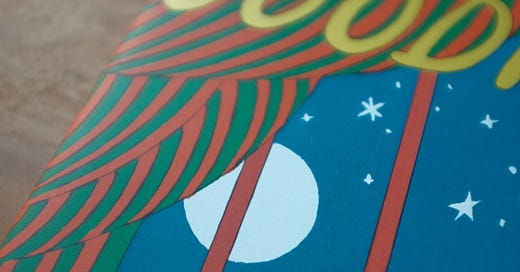



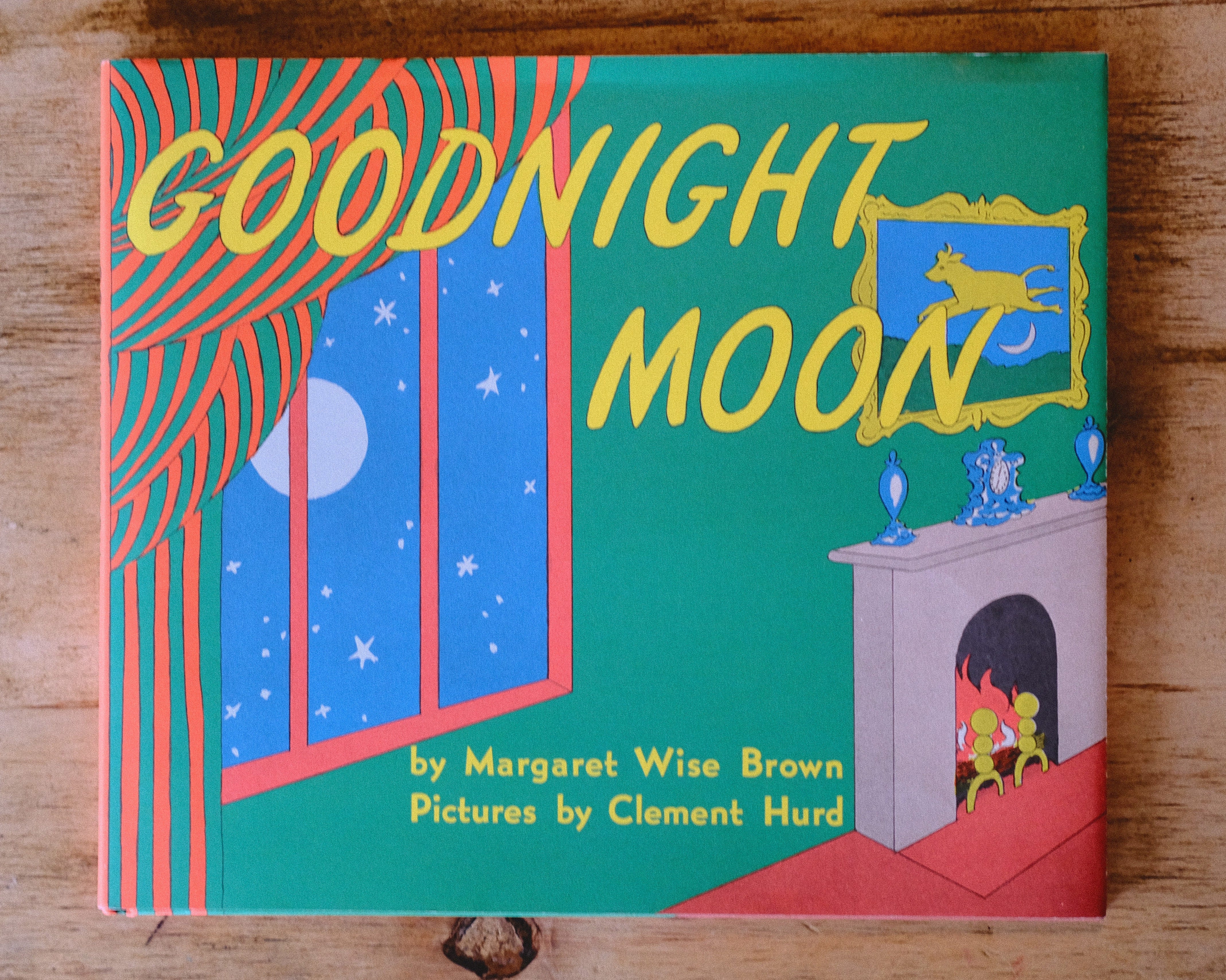



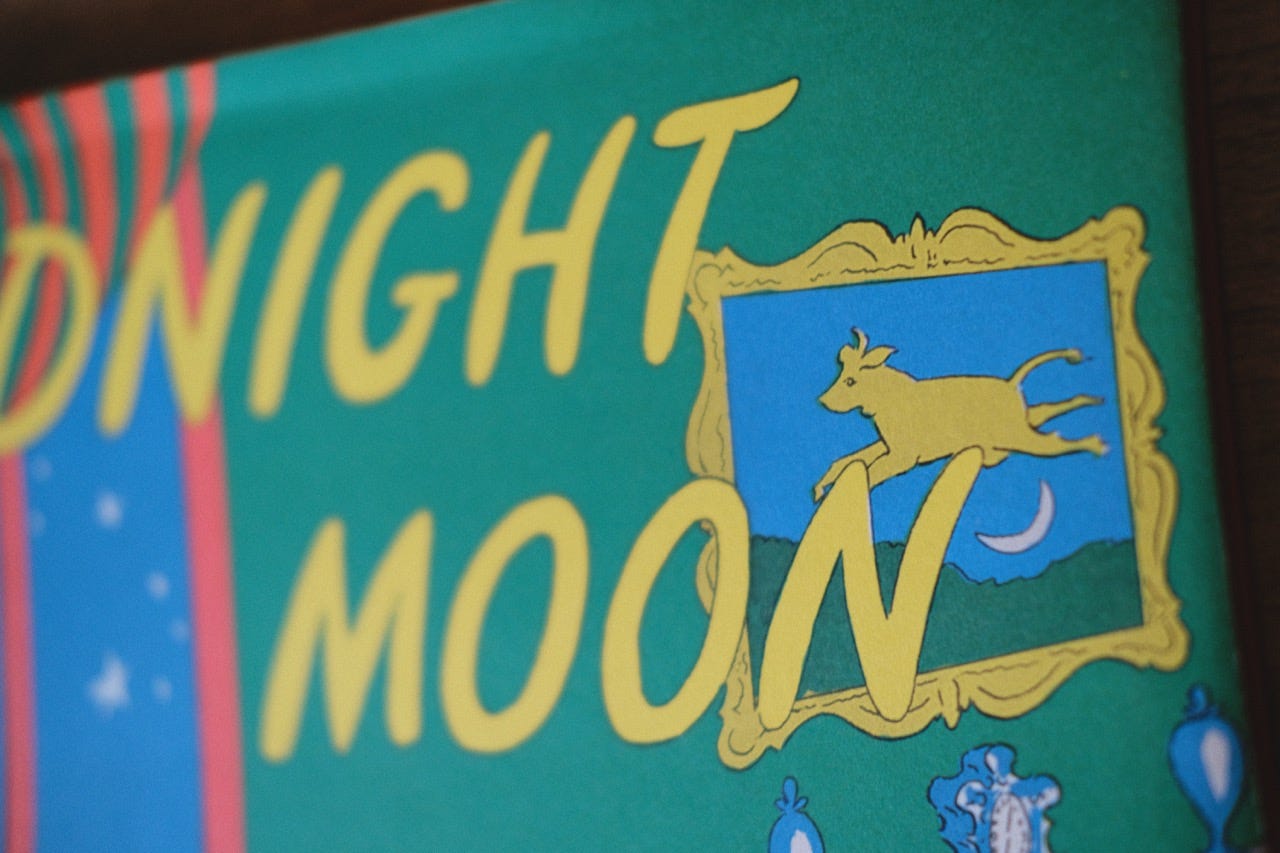

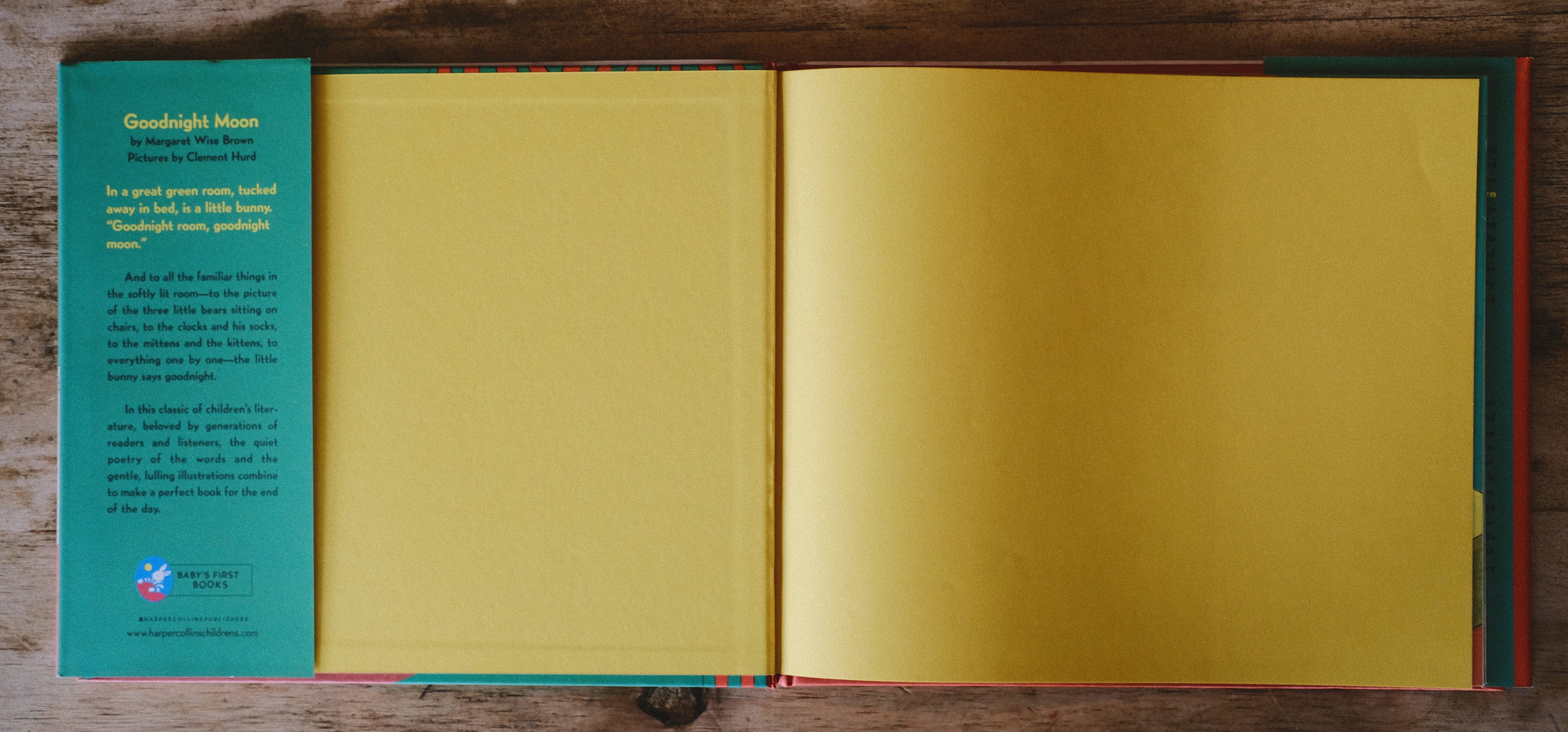



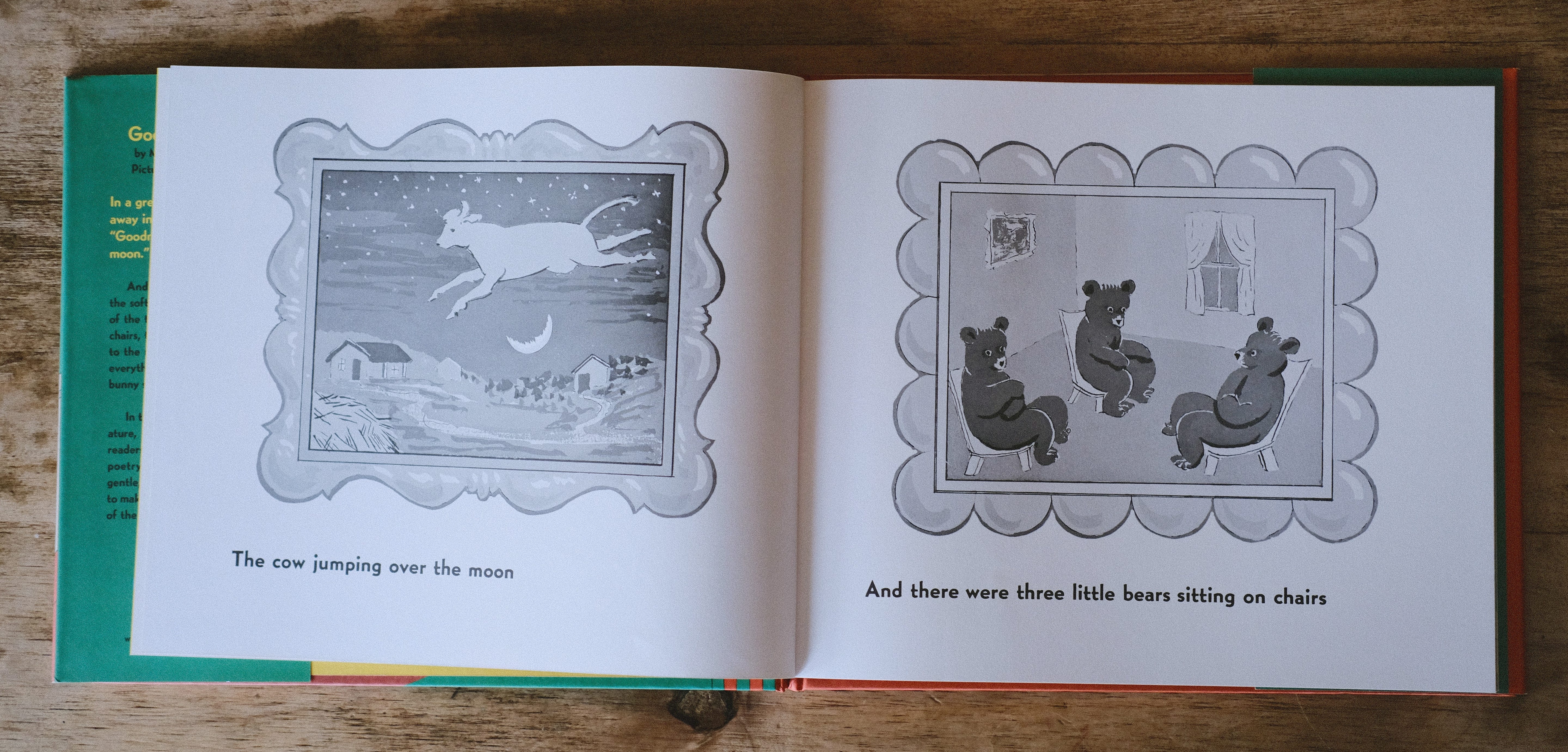


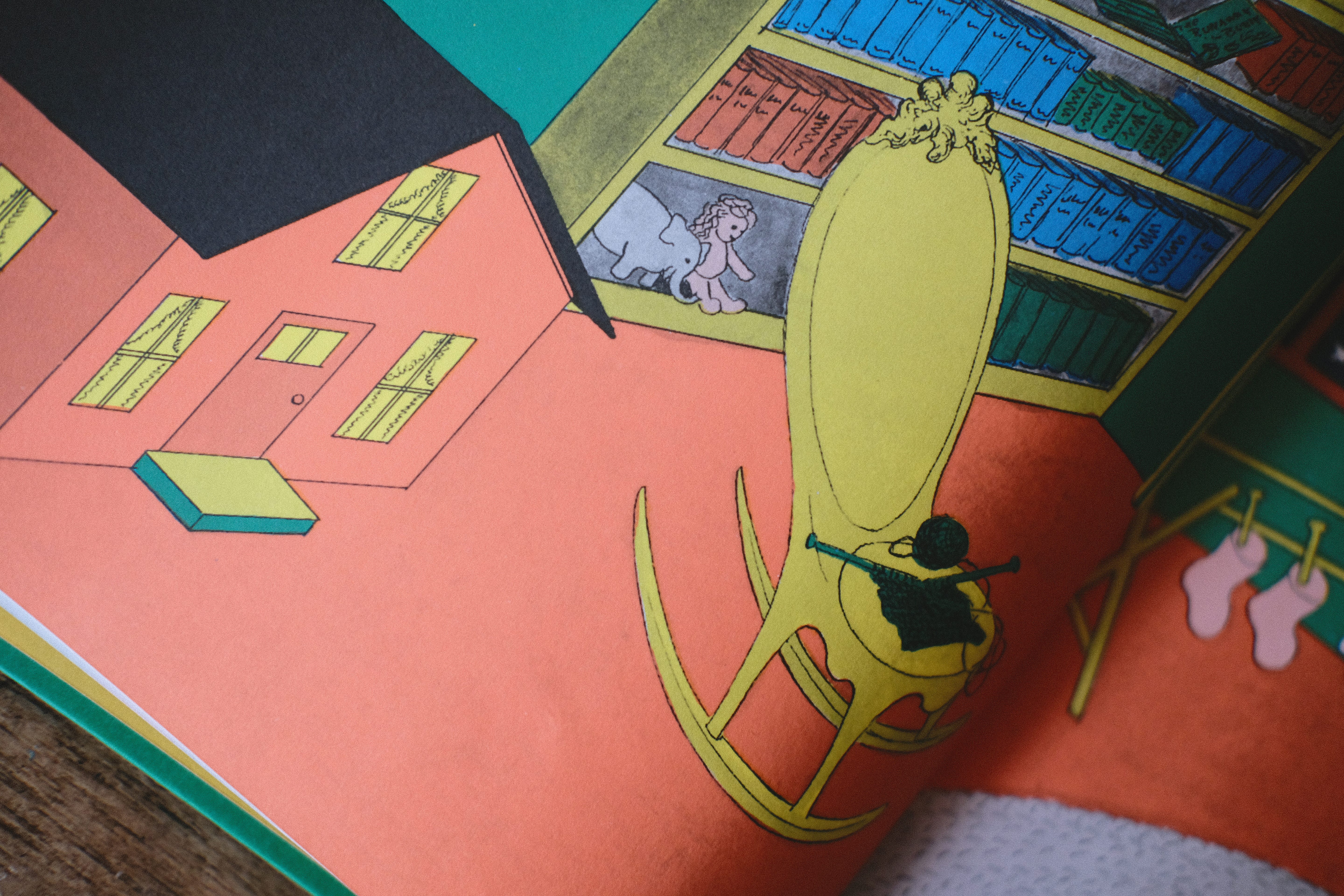

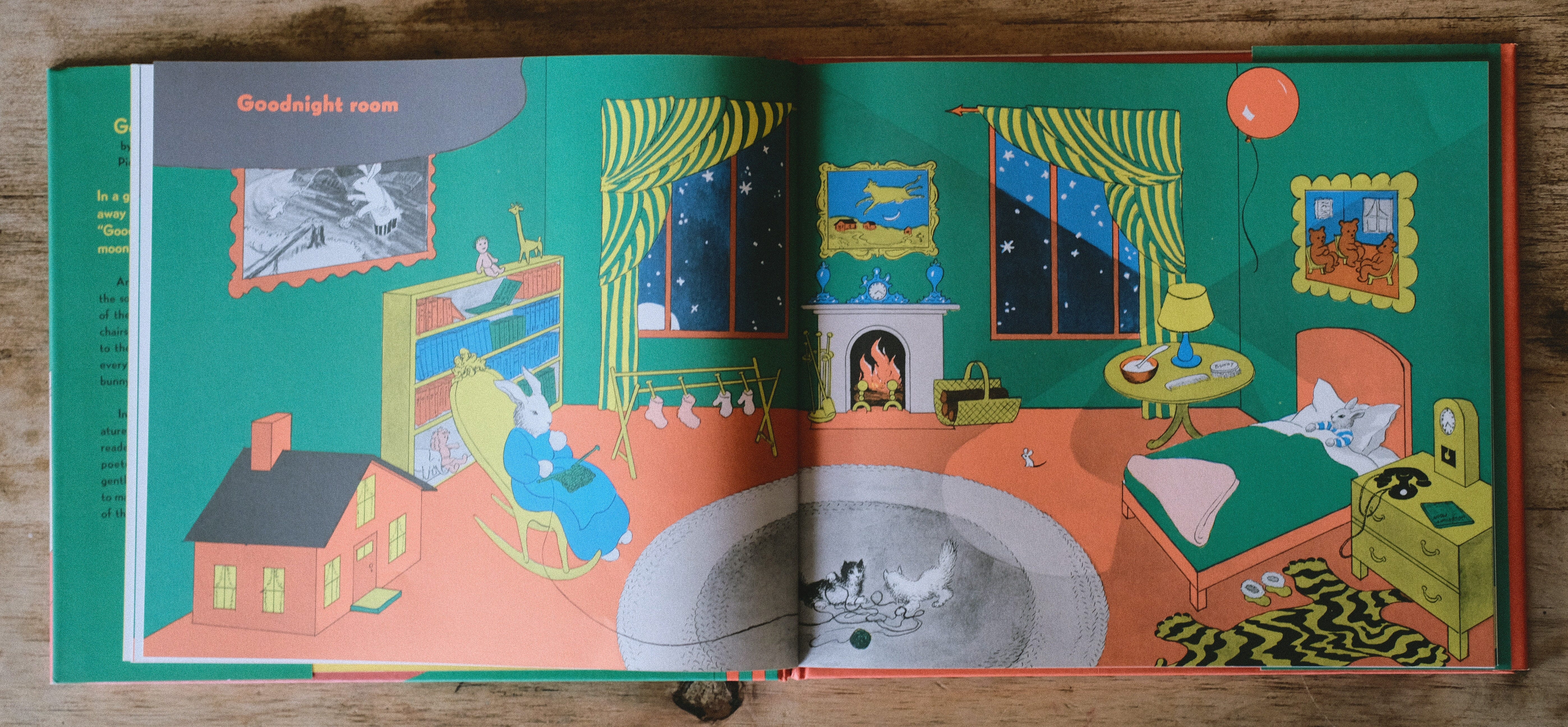
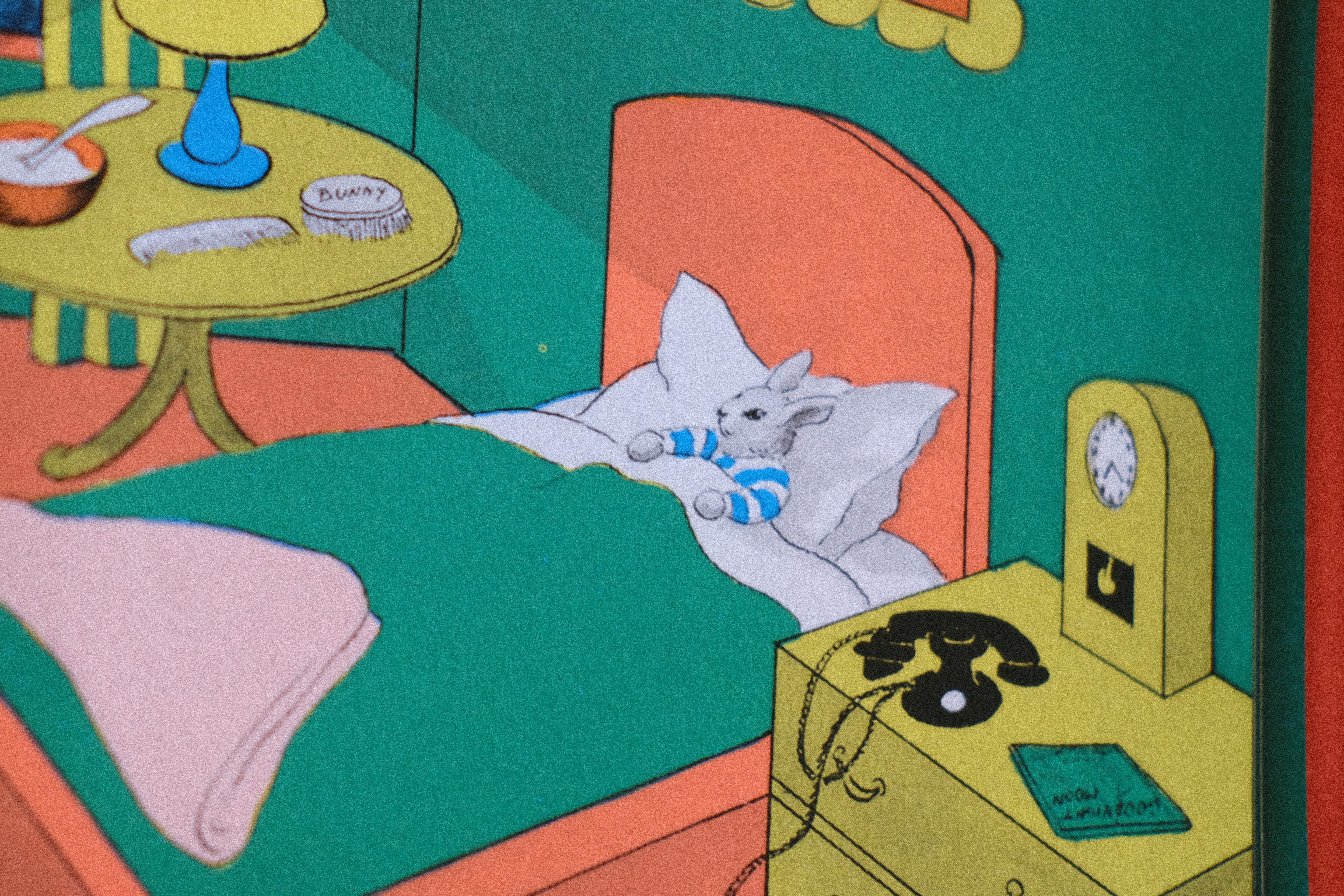


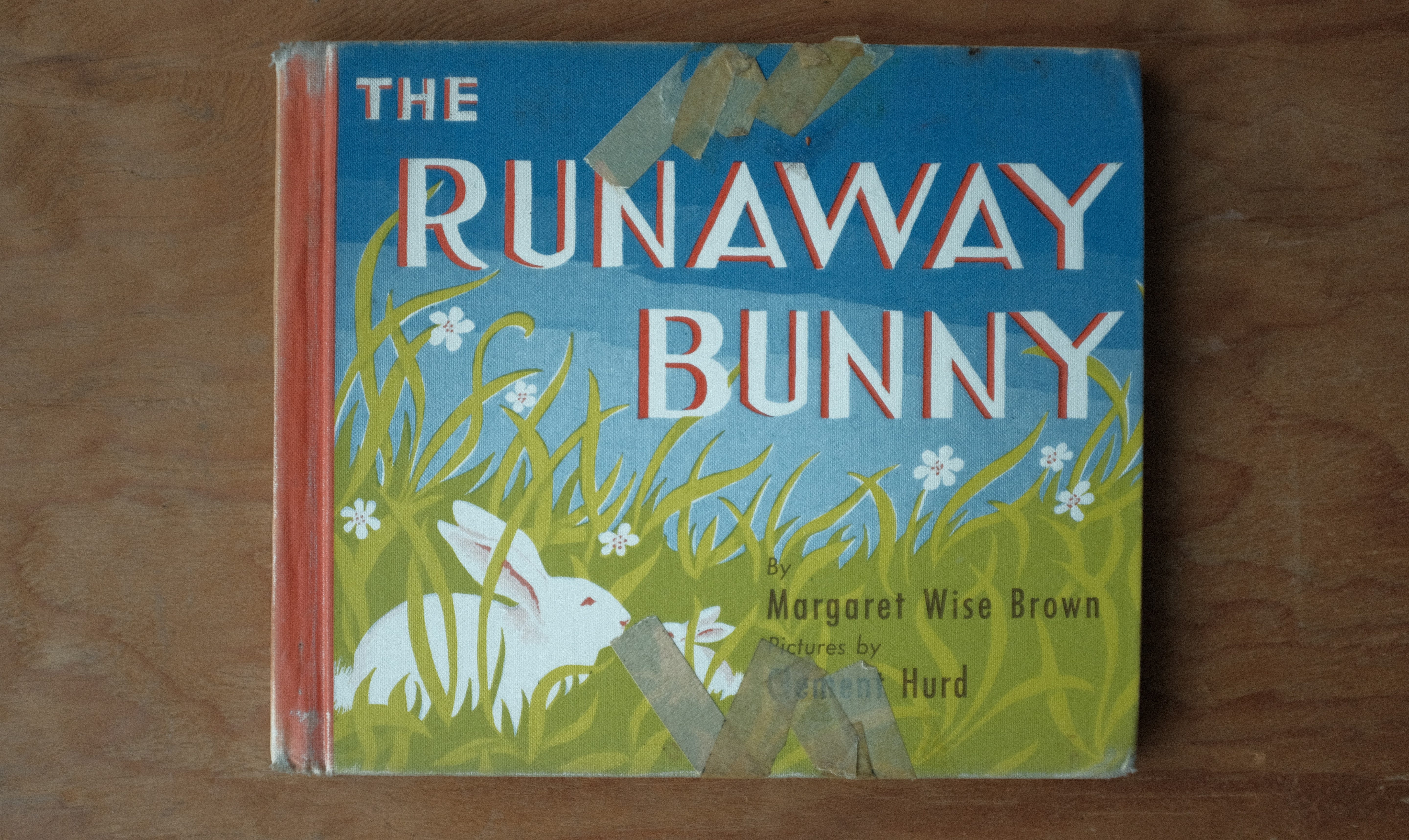
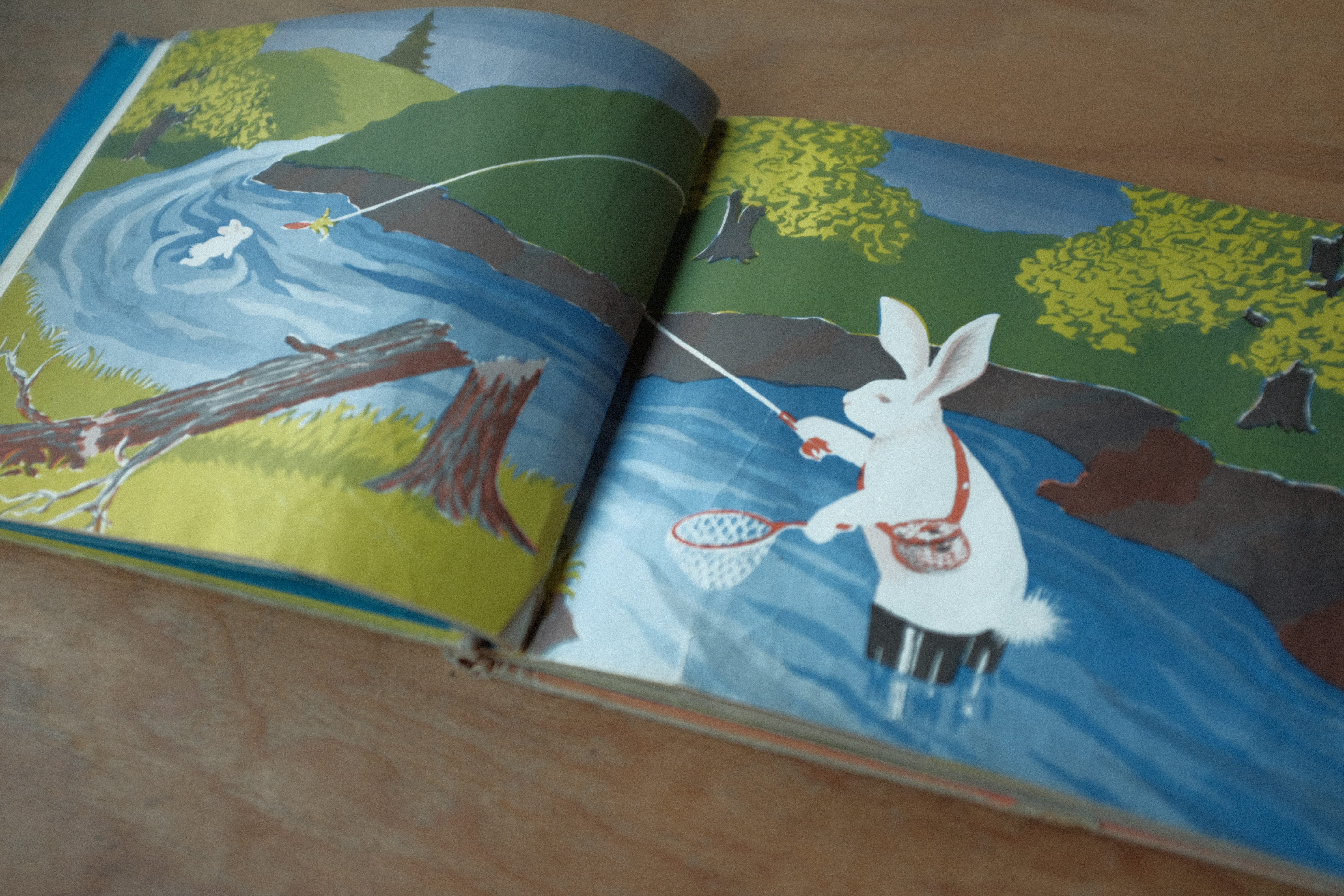
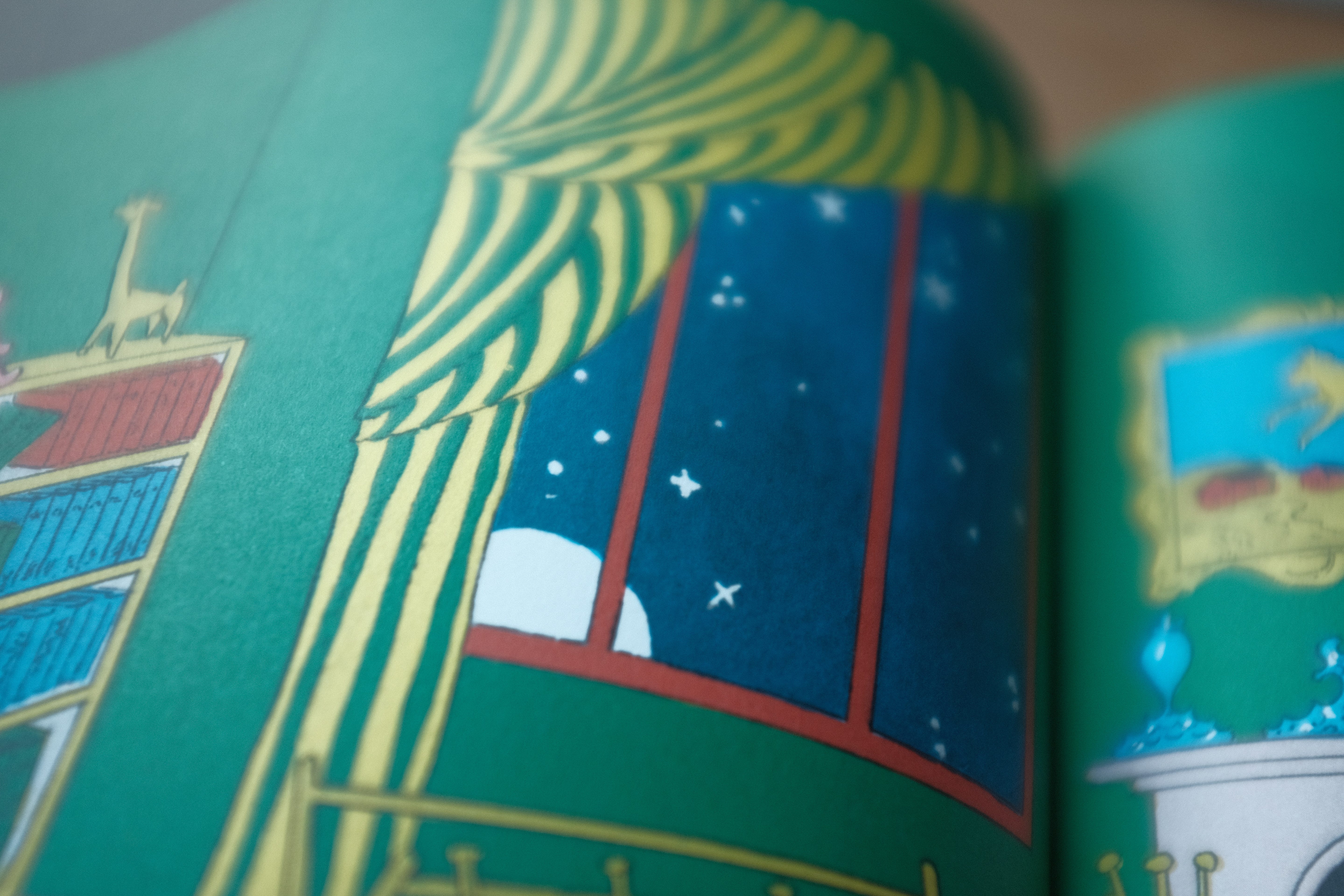
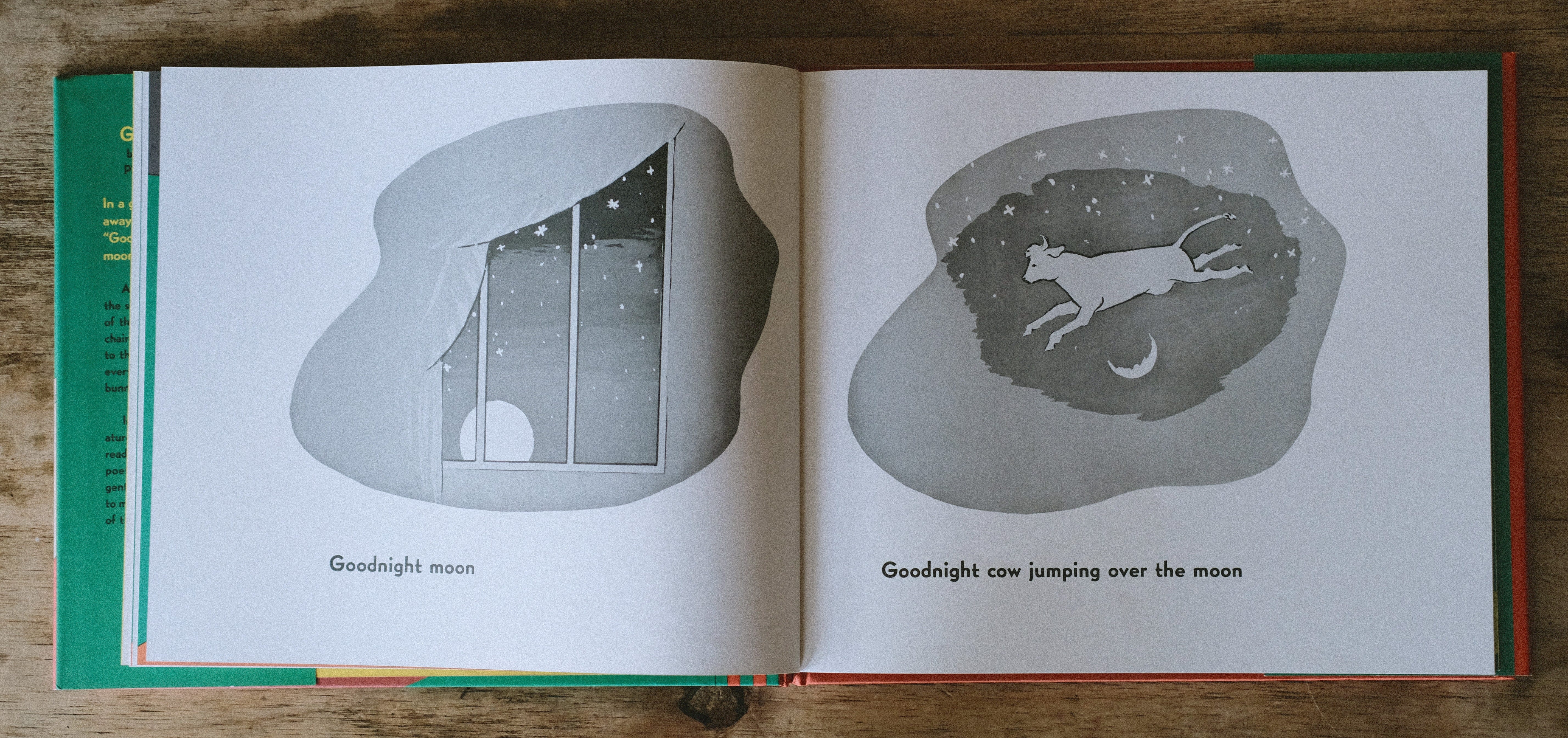



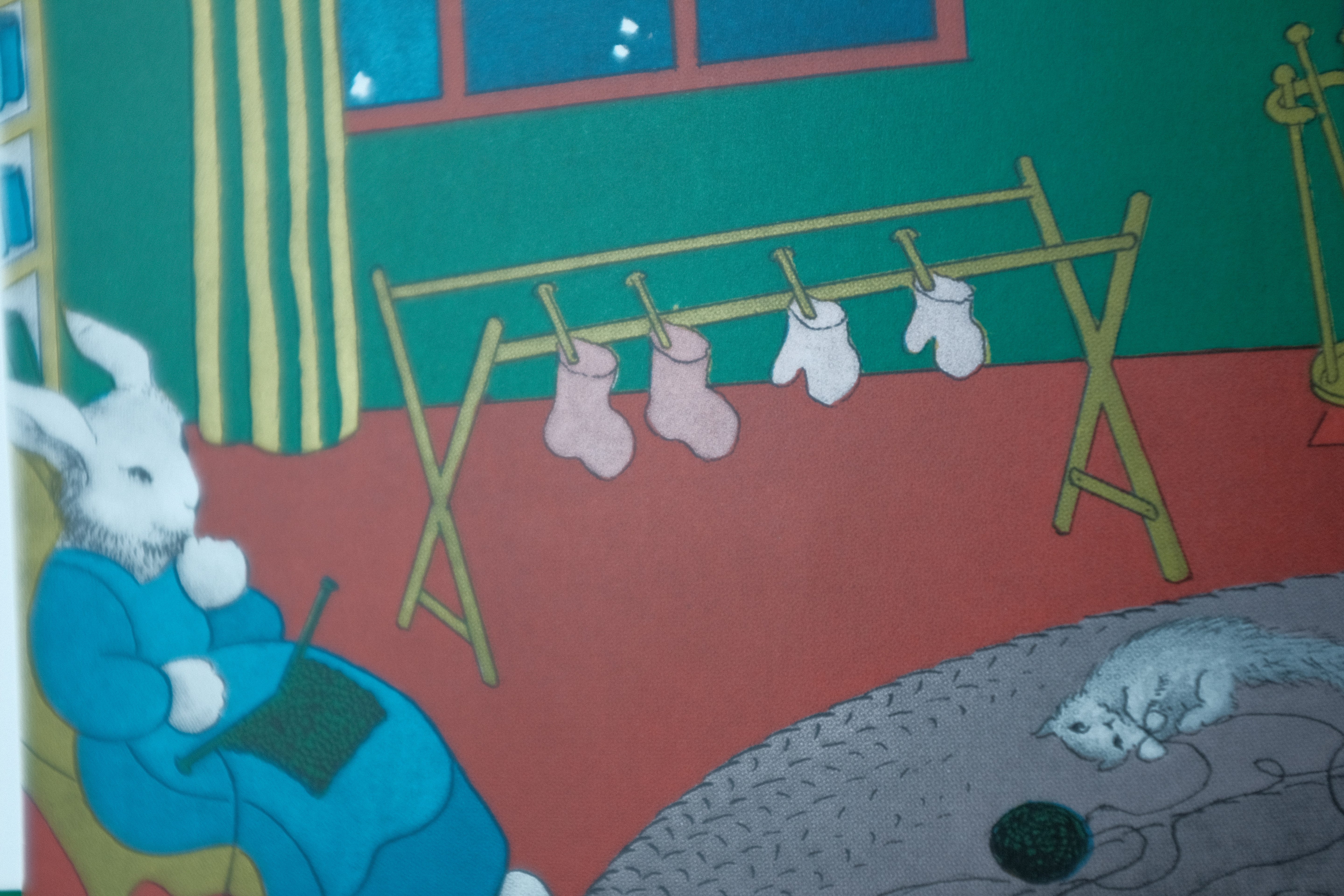


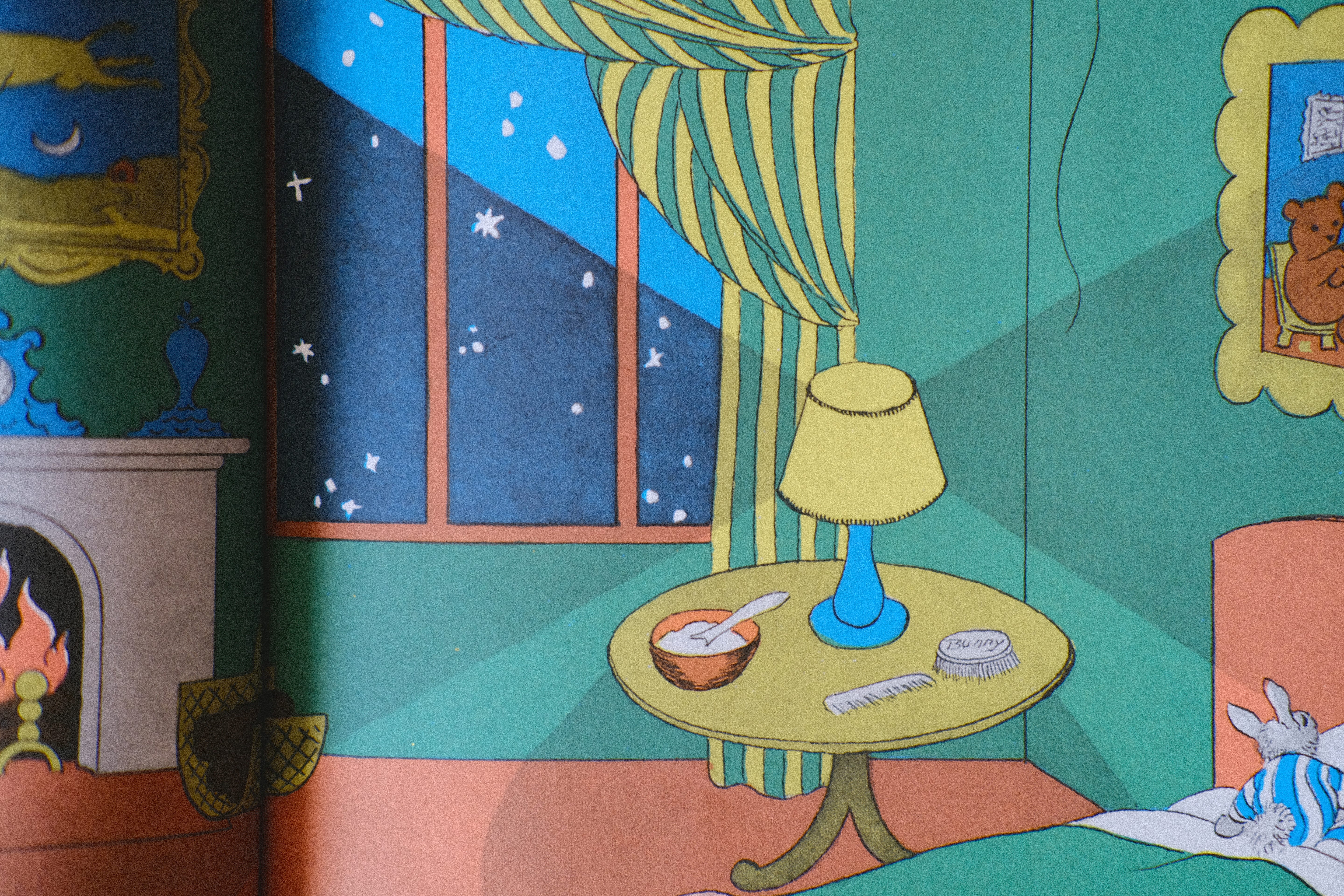

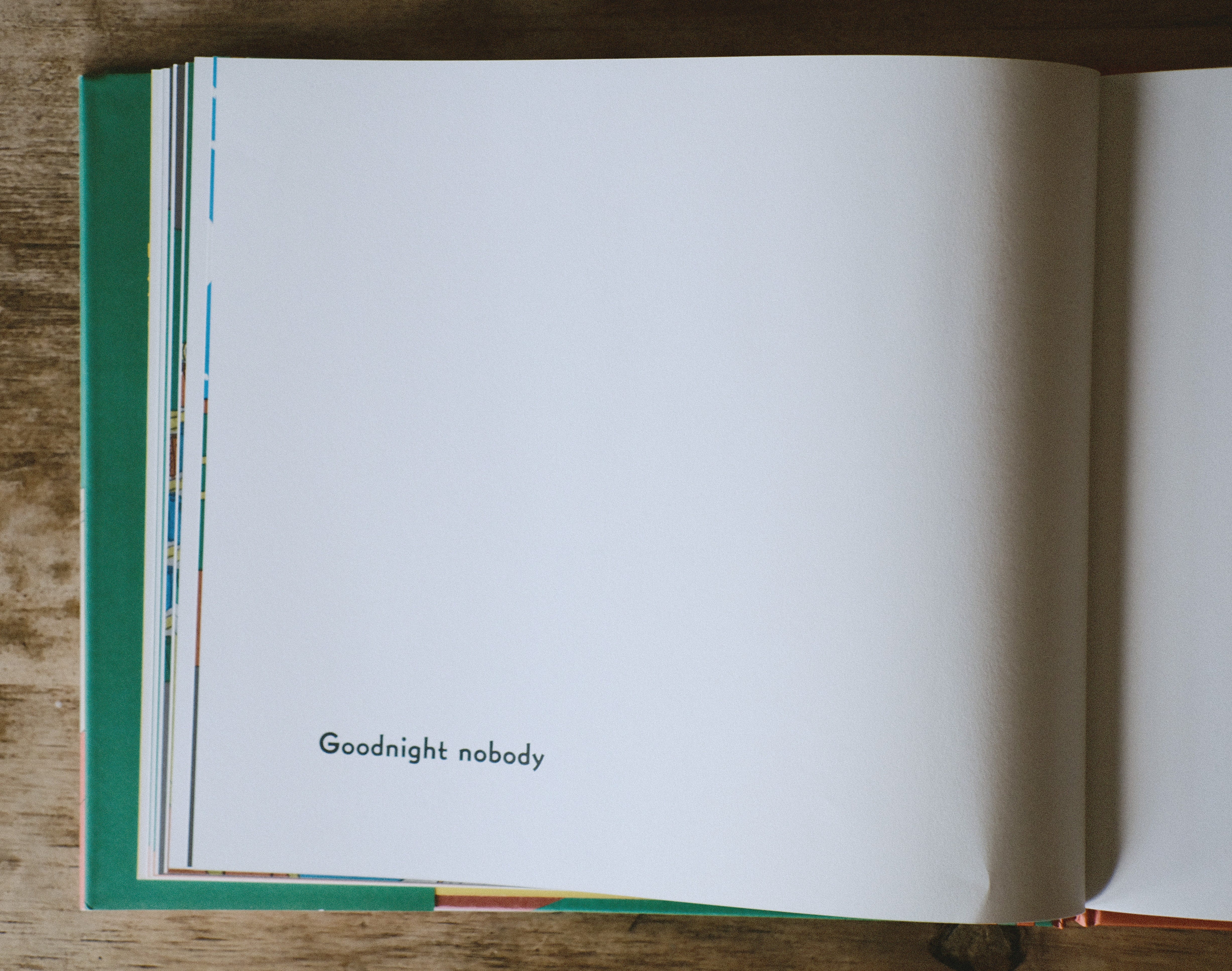

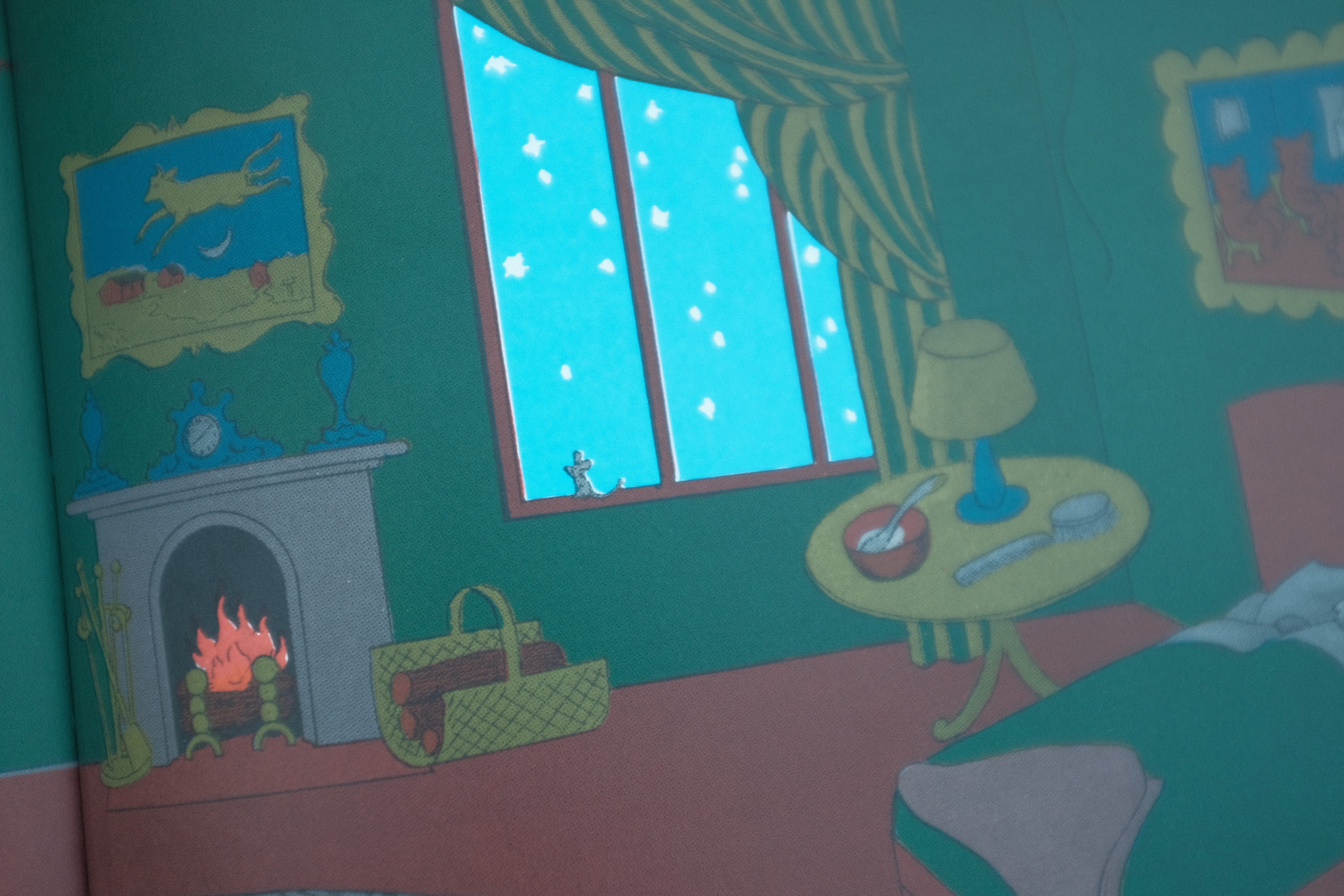
I am an American novelist and I love parties but even more than I love parties I love this substack and the two of you. <3
Wow, I loved every bit of this. Especially the Arrested Development reference. But also the spread with goodnight nobody and mush -- I had never thought about how it is life and death right next to each other. Which is a piece that helped me understand the whole mouse and cat B plot. It is interesting the mouse is specified as "young" because it connects the mouse with the young bunny, and both are simultaneously confronting death. For the mouse, it is the cats. For the bunny, it is sleep. And it is so fascinating that the mouse stays awake -- living another day -- while the bunny goes to sleep. Another reflection of life and death on the same spread! Anyway, thanks for this refreshing experience of a timeless (literally and figuratively) classic!